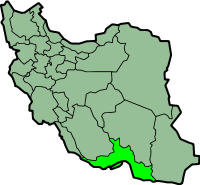Hormozgan
|
|
Qeshm.jpg
Hormozgan is one of the 30 provinces of Iran. It is in the south of the country, facing Oman. Its area is 68475 km2, and it's provincial capital is Bandar Abbas. The province has 14 islands located in the Persian Gulf, and 1000 km of coastline.
The province has eight major cities, namely: Bandar Abbas, Bandar Lengeh, Minab, Bandar Charak, Jask, Bastak, Bandar Khamir and Fin. The province also has 21 counties (or districts), 69 municipalities, and 2046 villages. In 1996, the population of the province was at almost 1.1 million.
| Contents |
History
Portugese-bandar-abbas.jpg
Although Hormozgan is known to have had settlements during the Achaemenid era and when Nearchus passed through this region, recroded history of the main port of Hormozgan ("Bandar-e-Hormoz") begins with Ardashir I of Persia of the Sassanid empire.
The province is said to have been particularly prosperous between 241 BC and 211 BC, but is said to have grown even further in trade and commercial significance after the arrival of the Islamic era.
Marco Polo visited the port of Bandar Abbas in 1272 and 1293, and reports widespread trading in Persian jewelry, the ivory and silk of IndoChina, and pearls from Bahrain in the Bazaars in the port of Hormuz.
In 1497, European colonialists landed in the region for the first time, headed by Vasco da Gama. In 1506, the Portugese, led by Alfonso d'Albuquerque invaded the area with 7 warships, under the pretext of protecting their interests from Egypt and Venice. The port of Hormuz was at this time considered a strategic port for commercial interests in the Persian Gulf.
Ismail I who was trying to counter the Ottomon empire to the west, was unable to save the port from the Portugese, until Shah Abbas I was finally able to drive them out of the Persian Gulf with the aid of the British. The name of Bandar Abbas comes directly from the name of Shah Abbas I.
The British, meanwhile were competing for influence in the region with Dutch colonialists who finally invaded Qeshm island and dispatched warships to Bandar Abbas during the final years of Shah Abbas' reign. The Persian government was unable to defend itself against this attack. However, with the souring of British and Dutch relations, military tensions further grew in the region. The Dutch finally resorted to moving their base up to Kharg Island.
The Amir of Kharg, Mir Mahna, was however able to defeat the Dutch forces at Kharg, leaving the British firmly in charge of the entire region. Soon Britain took control over the entire Persian Gulf via the interests of British East India Company. The British adopted a policy of encouraging local autonomy throught the Persian Gulf so as to prevent any possible formiddable unified force from threatening their establishments in the Persian Gulf.
The strategic importance of the Persian Gulf further increased after WW1 with the discovery of oil in the region.
Geography and Culture
Bandarabbas-hindu.jpg
The province experiences very hot and humid climate, with temperatures sometimes exceeding 120F (52C) in summers. There is very little percipitation year round.
Islands of the province
Fourteen Iranian islands in the Persian Gulf are part of this province, including:
- Qeshm,
- Kish,
- Greater and Lesser Tunbs,
- Abu Musa,
- Lavan,
- Hengam,
- Hormuz,
- Sirri,
- Forur,
- Forurgan,
- Shotur,
- Lark,
- Hendurabi
Hormozgan today
Bandar-abbas-old.jpg
Hormozgan today has 11 ports, 5 national airports, and 3 international airports. The province has an active agriculture sector, ranking first in Iran in lime production and second in date production. 30% of Iran's fishery produce comes from this province. Two major hydro dams serve the water needs of the province, namely Jegin Dam and Shemil Dam.
Germany has recently offered to build a bridge that would connect Qeshm island to the mainland, a formiddable project.
Hormozgan has two free trade zones, one in Kish, the other on Qeshm island.
Attractions
Hormozgan has 4 and 5 star hotels with modern amenities. The Cultural Heritage Organization of Iran lists 212 sites of historical and cultural significance in the province. Some of the more popular attractions are:
- Emarat e Kolah Farangi (built by and during the Dutch occupation)
- Berkeh haye Baran (6 traditional water reservoirs)
- Gele-dari traditional Bath
- The Hindu temple
- Latidan Bridge, built during the era of Shah Abbas I
- Fekri House
- Sa'di House
- The Portugese fortress
- Qeshm Island
- Kish Island, the most popular tourist resort in southern Iran in the Persian Gulf.
- Geno UNESCO natural biosphere reserve
- Hara UNESCO natural biosphere reserve
- Various hotwater springs
Colleges and Universities
- Bandar Abbas University of Medical Sciences (http://www.hums.ac.ir/)
- University of Hormozgan (http://www.hormozgan.ac.ir/)
- Qeshm Institute of Higher Education (http://www.qeshm.ac.ir/)
- Islamic Azad University of Bandar Abbas (http://www.iauba.ac.ir/)
- Kish University
External links
- Official website of Hormozgan Governorship (http://www.hormozgan.ir/)
- Hormozgan Cultural Heritage Organization (http://www.hormozganmiras.ir/)
- Hara UNESCO Biosphere Reserve (http://www2.unesco.org/mab/br/brdir/directory/biores.asp?code=IRA+05&mode=all)
- Geno UNESCO Biosphere Reserve (http://www2.unesco.org/mab/br/brdir/directory/biores.asp?code=IRA+03&mode=all)
| Provinces of Iran | 
|
|---|---|
| Ardabil | Bushehr | Chahar Mahaal and Bakhtiari | East Azarbaijan | Isfahan | Fars | Guilan | Golestan | Hamadan | Hormozgan | Ilam | Kerman | Kermanshah | Khuzestan | Kohkiluyeh and Buyer Ahmad | Kurdistan | Lorestan | Markazi | Mazandaran | North Khorasan | Qazvin | Qom | Razavi Khorasan | Semnan | Sistan and Baluchistan | South Khorasan | Tehran | West Azarbaijan | Yazd | Zanjan | |

